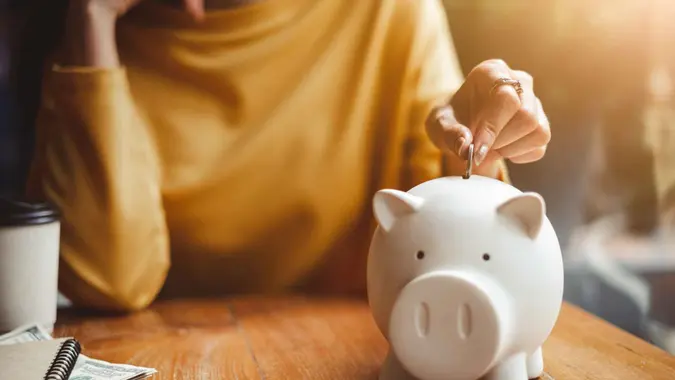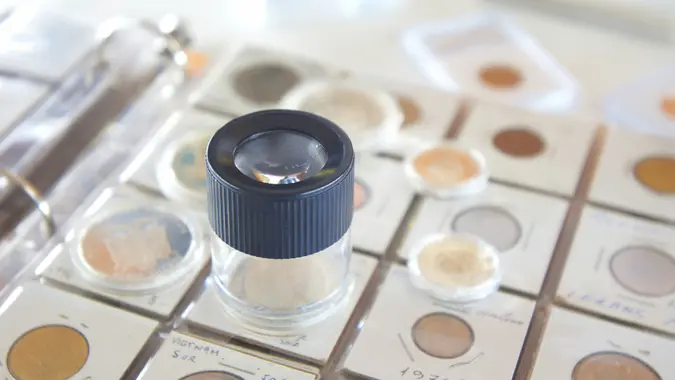4 Decades of Valuable Coins: See Which Are Worth the Most From 1930 to 1970

Commitment to Our Readers
GOBankingRates' editorial team is committed to bringing you unbiased reviews and information. We use data-driven methodologies to evaluate financial products and services - our reviews and ratings are not influenced by advertisers. You can read more about our editorial guidelines and our products and services review methodology.

20 Years
Helping You Live Richer

Reviewed
by Experts

Trusted by
Millions of Readers
Do you want to get into coin collecting? Some of the most expensive coins ever sold at auction were minted in the U.S., many within the past century. You might still find them in circulation, or even in your parents’ or grandparents’ attics. Read on for a roundup of the most valuable coins from the 1930s, ’40s, ’50s and ’60s to see if you may have hidden treasure of your own.
What Makes a Coin Valuable?
Coins can be worth much more than their face value, usually because they have unique traits that appeal to collectors. One such trait is the rarity of the coin, determined by such variables as being minted in limited numbers or belonging to a batch with defects.
For example, in 2021, a 1933 Gold Double Eagle coin sold at auction for over $18 million. It fetched such a high price because of its extreme scarcity, as it is one of only 13 surviving coins from its batch that avoided being melted down. It is also the only one that a private citizen can legally own — the rest reside in the U.S. Mint and the Smithsonian.
Condition also influences a coin’s value. Coins in pristine, or “mint” condition, especially those that never circulated, can fetch much higher prices than those that show wear and tear. Collectors are willing to pay a premium for coins that remain as close to their original state as possible.
Even if the coin isn’t particularly valuable due to its rarity or history, its metal content can add worth. Coins made of silver or gold might sell for more than their face value due to the material itself. Be careful, though — melting down U.S. currency for profit can be illegal, so it’s probably best not to do this yourself.
Roundup of the Most Valuable Coins: 1930s to 1960s
1930s
- 1933 Double Eagle — Auction Record: $18,872,250 (June 2021)
- 1933 Indian Head Gold Eagle — Auction Record: $881,250 (June 2016)
- 1932-D Washington Quarter — Auction Record: $143,750 (April 2008)
- 1934 Peace Dollar — Auction Record: $108,000 (August 2018)
- 1937-D Three-Legged Buffalo Nickel — Auction Record: $99,875 (October 2021)
- 1938-D Walking Liberty Half Dollar — Auction Record: $44,400 (September 2020)
- 1932-D Lincoln (Wheat) Penny — Auction Record: $25,200 (February 2021)
1940s
- 1940s Lincoln Wheat Penny — Auction Record: $435,000
- 1940-D 5C, FS (Regular Strike) Jefferson Five Cents — Auction Record: $21,737.50
- 1940 50C (Regular Strike) Walking Liberty Half Dollars — Auction Record: $29,375
- 1940 10C, FB (Regular Strike) Mercury Dimes — Auction Record: $35,250
- 1940-D 25C (Regular Strike) Washington Quarter — Auction Record: $4,060
1950s
- 1950 and 1951 Proof Half Dollars — Typically worth hundreds to thousands of dollars depending on condition
- 1950 and 1951 Washington Quarter and Roosevelt Dime Proofs — Could reach hundreds to thousands of dollars when well-preserved
- 1950s Circulated Silver Dimes, Quarters and Half Dollars — Worth over $10 for half dollars, over $5 for quarters and over $2 for dimes, based on the silver content
- 1950 and 1951 Dr. Booker T. Washington Half Dollars — Generally valued between $25-$50, but potentially thousands if in near-perfect condition
1960s
- 1963-D Silver Washington Quarter Regular Strike — Could sell for $16,000 or more (one was auctioned for $24,000 in 2022)
- 1965 Type 2 Clad Washington Quarter Business Strike — Sold in mint condition for $12,650 in 2005
- 1962-D Silver Washington Quarter Regular Strike — Auctioned for $18,400 in 2012
- 1960 Penny, No Mint Mark, Deep Cameo — Could be worth up to $2,600, depending on condition
- 1960 Ben Franklin Half Dollar — Worth at least $11 or $12 today, potentially up to $300 or more in mint condition
Takeaways
Coin collecting can be a lucrative hobby, especially if you discover a rare coin out in the wild, where no one else knows what it’s worth. It’s crucial to ensure authenticity before purchasing any coins. If it is already certified by the Professional Coin Grading Service (PCGS), then it is likely to be genuine. That said, if the coin has been graded, that may indicate the price you’re getting might not be a great deal, since the seller likely already knows its value.
Always know how much a specific coin in that condition should be worth before handing over the cash. Slight differences in minting or condition can make a coin either worth thousands of dollars, or relatively worthless.
 Written by
Written by  Edited by
Edited by 

























